National Institutes of Technology
The National Institutes of Technology (NITs) are autonomous public technical and research universities located in India and are among most reputable institutes of technology in the world. They are governed by the National Institutes of Technology Act, 2007, which declared them as institutions of national importance and lays down their powers, duties, and framework for governance. The National Institutes of Technology Act, 2007 lists thirty-one institutes. Each NIT is autonomous, linked to the others through a common council (NIT Council), which oversees their administration and all NITs are funded by the Government of India.[1] The Minister of Human Resource Development is the ex officio Chairperson of the NIT Council. These institutes are among the top-ranked engineering colleges in India and have one of the lowest acceptance rates for engineering institutes, of around 1 to 2 percent. The language of instruction is English at all these institutes.[2][3] As of 2019, the total number of seats for undergraduate programs was 21,133 and for postgraduate programs 10,550 in all the 31 NITs put together.[4][5]
Other name | NIT or NITs (plural) |
|---|---|
| Type | Public technical university |
| Established | 15 August 2007 via National Institutes of Technology Act, 2007 |
| Location | 31 places in India |
| Language | English |
| Website | www |

History
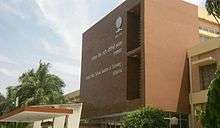
During the second five-year plan (1956–60) in India, a number of industrial projects were contemplated. To ensure enough supply of trained personnel to meet the demand for these projects, a decision was taken to start the Regional Engineering Colleges (RECs), at the rate of one per each major state, which can churn out graduates with good engineering merit at the standards of the Indian Institutes of technology.The admission used to be highly selective. Thus, seventeen RECs were established from 1959 onwards in each of the major states. Each college was a joint and cooperative enterprise of the central government and the concerned state government. The Government opened 8 RECs in 1960 two in each region, as follows:
| Region | Regional Engineering Colleges (REC) |
|---|---|
| Eastern Region | Durgapur and Jamshedpur |
| Western Region | Nagpur, Surat and Bhopal |
| Southern Region | Warangal and Surathkal |
| Northern Region | Srinagar and Allahabad |
Later on, 5 more were added by 1965. The early 14 Institutes were Srinagar, Warangal, Calicut, Durgapur, Kurukshetra, Jamshedpur, Jaipur, Nagpur, Rourkela, Surathkal, Surat, Tiruchirappalli, Bhopal, and Allahabad. It established one in Silchar in 1967 and added two others located at Hamirpur in 1986, and Jalandhar in 1987.
These were large-sized institutions judged by the standards then prevailing in the country. The considerations that weighed in this decision were :
A large-sized college would be more efficient than the equivalent small colleges, the proposed colleges have to meet the additional requirements of the country as a whole and for that purpose should have to function on an all-India basis. Therefore, the smaller they are in number and the larger in size, the better, and for the same reason their location is important from an all-India point of view.
The RECs were jointly operated by the central government and the concerned state government. Non-recurring expenditures and expenditures for post-graduate courses during the REC period were borne by the central government while recurring expenditure on undergraduate courses was shared equally by central and state governments.
The success of the technology-based industry led to high demand for technical and scientific education. Due to the enormous costs and infrastructure involved in creating globally respected Indian Institutes of Technology (IITs), in 2002 Ministry of Human Resource Development (MHRD) Minister Murli Manohar Joshi decided to upgrade RECs to "National Institutes of Technology" (NITs) instead of creating IITs. The central government controls NITs and provides all funding. In 2002, all RECs became NITs.


The upgrade was designed along the lines of the Indian Institutes of Technology (IITs) after it was concluded that RECs had potential as proven by the success of their alumni and their contributions in the field of technical education and that they were on par with the IITs. Subsequently, funding and autonomy for NITs increased, and they award degrees that have raised their graduates' perceived value.These changes implemented recommendations of the "High Powered Review Committee" (HPRC). The HPRC, chaired by R.A. Mashelkar, submitted its report entitled "Strategic Road Map for Academic Excellence of Future RECs" in 1998.
In 2004, MHRD issued NIT status to three more colleges, located at Patna (Bihar Engineering College, a 110-year-old college), Raipur (Government Engineering College), and Agartala (Tripura Engineering College). Based on the request of state governments and feasibility, future NITs are either converted from existing institutes or can be freshly created. The 21st (and the first brand-new) NIT is planned for Imphal in the north-eastern state of Manipur at an initial cost of Rs. 500 crores. In 2010, the government announced setting up ten new NITs in the remaining states/territories. This would lead to every state in India having its own NIT.
With the technology-based industry's continuing growth, the government decided to upgrade twenty National Institutes of Technology to full-fledged technical universities. Parliament passed enabling legislation, the National Institutes of Technology Act in 2007 and took effect on 15 August of that year. The target is to fulfill the need for quality manpower in the field of engineering, science, and technology and to provide consistent governance, fee structure, and rules across the NITs. The law designates each NIT an Institute of National Importance (INI).[6]
The Parliament of India on 1 August 2016 passed a bill to establish the NIT Andhra Pradesh, on a day members of parliament of the ruling Telugu Desam Party from the state staged a protest to demand special category status. The National Institutes of Technology, Science Education and Research (Amendment) Bill, 2016 was passed by Rajya Sabha by voice vote. The bill was passed in Lok Sabha on 21 July 2016.[7]
Institutes
| Serial No | Name | Photo | Abbreviation | Founded | Established | City/Town | State/UT |
|---|---|---|---|---|---|---|---|
| 1 | NIT Allahabad |  |
MNNIT | 1961 | 2001 | Prayagraj | Uttar Pradesh |
| 2 | NIT Bhopal | MANIT | 1960 | 2002 | Bhopal | Madhya Pradesh | |
| 3 | NIT Calicut |  |
NITC | 1961 | 2002 | Kozhikode | Kerala |
| 4 | NIT Durgapur | 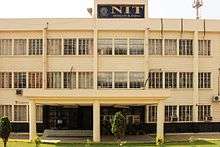 |
NITDGP | 1960 | 2002 | Durgapur | West Bengal |
| 5 | NIT Hamirpur | NITH | 1986 | 2002 | Hamirpur | Himachal Pradesh | |
| 6 | NIT Jaipur | 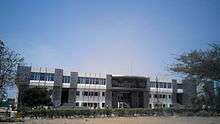 |
MNIT | 1963 | 2002 | Jaipur | Rajasthan |
| 7 | NIT Jalandhar | 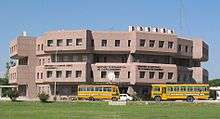 |
NITJ | 1987 | 2002 | Jalandhar | Punjab |
| 8 | NIT Jamshedpur |  |
NITJSR | 1960 | 2002 | Jamshedpur | Jharkhand |
| 9 | NIT Kurukshetra | NITKKR | 1963 | 2002 | Kurukshetra | Haryana | |
| 10 | NIT Nagpur |  |
VNIT | 1960 | 2002 | Nagpur | Maharashtra |
| 11 | NIT Rourkela |  |
NITR | 1961 | 2002 | Rourkela | Odisha |
| 12 | NIT Silchar |  |
NITS | 1967 | 2002 | Silchar | Assam |
| 13 | NIT Karnataka | NITK | 1960 | 2002 | Suratkhal | Karnataka | |
| 14 | NIT Warangal | NITW | 1959 | 2002 | Warangal | Telangana | |
| 15 | NIT Srinagar |  |
NITSRI | 1960 | 2003 | Srinagar | Jammu and Kashmir |
| 16 | NIT Surat | 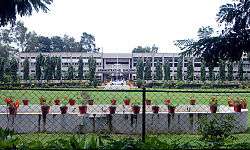 |
SVNIT | 1961 | 2003 | Surat | Gujarat |
| 17 | NIT Tiruchirappalli | 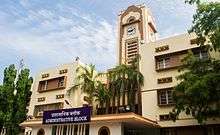 |
NITT | 1964 | 2003 | Trichy | Tamil Nadu |
| 18 | NIT Patna | 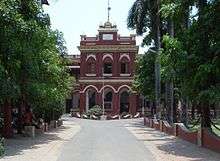 |
NITP | 1886 | 2004 | Patna | Bihar |
| 19 | NIT Raipur | NITRR | 1956 | 2005 | Raipur | Chhattisgarh | |
| 20 | NIT Agartala | 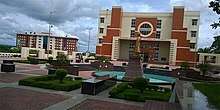 |
NITA | 1965 | 2006 | Agartala | Tripura |
| 21 | NIT Arunachal Pradesh | NITAP | 2010 | 2010 | Yupia | Arunachal Pradesh | |
| 22 | NIT Delhi | NITD | 2010 | 2010 | New Delhi | Delhi | |
| 23 | NIT Goa | NITG | 2010 | 2010 | Farmagudi | Goa | |
| 24 | NIT Manipur | NITMN | 2010 | 2010 | Imphal | Manipur | |
| 25 | NIT Meghalaya | NITM | 2010 | 2010 | Shillong | Meghalaya | |
| 26 | NIT Mizoram | NITMZ | 2010 | 2010 | Aizawl | Mizoram | |
| 27 | NIT Nagaland | NITN | 2010 | 2010 | Dimapur | Nagaland | |
| 28 | NIT Puducherry | NITPY | 2010 | 2010 | Karaikal | Puducherry | |
| 29 | NIT Sikkim | NITSKM | 2010 | 2010 | Ravangla | Sikkim | |
| 30 | NIT Uttarakhand | NITUK | 2010 | 2010 | Srinagar, Uttarakhand | Uttarakhand | |
| 31 | NIT Andhra Pradesh | NITANP | 2015 | 2015 | Tadepalligudem | Andhra Pradesh | |
Organisational structure
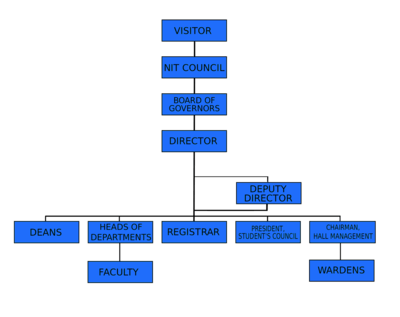
The President of India is the ex officio visitor of all the NITs. The NIT Council works directly under him and it includes the minister-in-charge of technical education in Central Government, the Chairmen and the Directors of all the NITs, the Chairman of University Grants Commission (UGC), the Director-General of Council of Scientific and Industrial Research (CSIR), the Directors of other selected central institutions of repute, members of Parliament, Joint Council Secretary of Ministry of Human Resource Development (MHRD), nominees of the Central Government, All India Council for Technical Education (AICTE), and the Visitor.
Below the NIT Council is each NIT's Board of Governors. The Board of Governors of each NIT consists of the following members:
- Chairman - an eminent technologist / engineer / educationist to be nominated by the Government of India.
- Member Secretary - Director of the NIT.
- Nominee of the MHRD, Government of India.
- Nominee of the Department of the Higher / Technical Education of the respective state government.
- Head of another technical institution in the region or an eminent technologist to be nominated by Central Govt.
- Director, IIT (in the region) or his nominee.
- Nominee of the UGC not below the rank of a Deputy Secretary.
- Nominee of the AICTE not below the rank of an Advisor.
- An alumnus of the institute from amongst alumni in education/industry to be nominated by Board of Governors.
- Two representatives representing large, medium and small scale industries to be nominated by Central Government.
- One Professor and one Assistant Professor of the institute by rotation.
The Director serves under the Board of Governors and is the school's chief academic and executive officer. Academic policies are decided by its Senate, which is composed of some professors and other representatives. The Senate controls and approves the curriculum, courses, examinations, and results. Senate committees examine specific academic matters. The teaching, training, and research activities of various departments of the institute are periodically reviewed to maintain educational standards. The Director is the ex officio Chairman of the Senate. The Deputy Director is subordinate to the Director. Together they manage the Deans, Heads of Departments, Registrar, President of the Students' Council, and Chairman of the Hall Management Committee. Deans and Heads of Departments in NITs are administrative postings rather than career paths. Faculty members serve as Deans and Heads of Departments for limited periods, typically 2 to 3 years, then returning to regular faculty duties. The Registrar is the chief administrative officer and overviews day-to-day operations. Below the Head of Department (HOD), are the various faculty members (professors, assistant professors, and lecturers). The Warden serves under the Chairman of the Hall Management Committee.[9]
National Institutes of Technology Act
The National Institutes of Technology, Science Education and Research Act, 2007 was enacted by the Parliament of India to declare India's National Institutes of Technology as Institutes of National Importance. The Act received the assent of the President of India on 5 June 2007 and became effective on Independence Day, 2007. The National Institutes of Technology Act is the second law for technical education institutions after the Indian Institutes of Technology Act of 1961.[10][11]
NIT Council
The NIT Council is the supreme governing body of India's National Institutes of Technology (NIT) system. The NIT Council consists of chairmen, directors of all NITs along with the government nominees from various sectors with the Minister of Human Resource Development as the Chairman of the Council. The NIT Council is the highest decision-making body in the NIT fraternity and is answerable only to the Government of India. The NIT Council is expected to meet regularly and take steps conducive for maximum growth of the NITs as whole in the near future.[12]
Education
_of_the_institute.jpg)
The NITs along with the IITs receive comparatively higher grants than other engineering colleges in India. Average NIT funding increased to ₹100 crores ($15.4 million) by the year 2011. On average, each NIT also receives ₹ 20-25 crore ($3-3.8 million) under World Bank funded Technical Education Quality Improvement Program (TEQIP I and TEQIP II). Other sources of funds include student fees and research funding from industry and contributions from the alumni. The faculty-to-student ratio in the NITs is between 1:7 and 1:9. The cost borne by undergraduate students is around ₹ 250,000 (~$3600) per annum.[13] After students from SC and ST categories, physically challenged students will now be the beneficiaries of fee waiver at the NITs in India.
The various NITs function autonomously, and their special status as Institutes of National Importance facilitates the smooth running of NITs, virtually free from both regional as well as a student politics. Such autonomy means that NITs can create their own curricula and adapt rapidly to the changes in educational requirements, free from bureaucratic hurdles. The medium of instruction in all NITs is English. The classes are usually held between 8:30 am and 5:30 pm, though there are some variations within each NIT. All the NITs have public libraries for the use of their students. In addition to a collection of prescribed books, the libraries have sections for fiction and other literary genres. Electronic libraries allow students access to online journals and other periodicals through the AICTE-INDEST consortium, an initiative by the Ministry of Human Resource Development.[14] Students also have access to IEEE documents and journals.
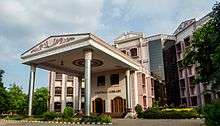
The academic policies of each NIT are decided by its Senate. This comprises all professors of the NIT and student representatives. Unlike many western universities that have an elected senate, the NITs have an academic senate. It controls and approves the curriculum, courses, examinations and results, and appoints committees to look into specific academic matters. The teaching, training and research activities of the institute are periodically reviewed by the senate to maintain educational standards. The Director of NIT is the ex-officio Chairman of the Senate.
Stringent faculty recruitment and industry collaboration also contribute to NIT success. Faculty other than lecturers must have a Ph.D. and relevant teaching and industry experience. Existing faculty who do not meet these criteria enroll under a Quality Improvement Programme (QIP) at IITs and IISc.
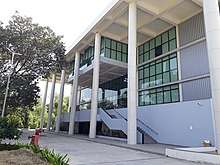
All the NITs follow the credits system of performance evaluation, with a proportional weighting of courses based on their importance. The total marks (usually out of 100) form the basis of grades, with a grade value (out of 10) assigned to a range of marks. Sometimes, relative grading is done considering the overall performance of the whole class. For each semester, the students are graded on a scale of 0 to 10 based on their performance, by taking a weighted average of the grade points from all the courses, with their respective credit points. Each semester evaluation is done independently and then the weighted average overall semesters is used to calculate the cumulative grade point average (CGPA).
Undergraduate education
The Bachelor of Technology (BTech) degree is the most common undergraduate degree in the NITs in terms of student enrollment. The BTech course is based on a 4-year program with eight semesters, while the Dual Degree and Integrated courses are 5-year programs with ten semesters. In all NITs, the first year of BTech and Dual Degree courses are marked by a common course structure for all the students, though in some NITs, a single department introduction related course is also included. The common courses include the basics from most of the departments like Electronics, Mechanics, Chemistry, Electrical, and Physics. At the end of the first year, some NITs offer an option to the meritorious students to change departments on the basis of their performance in the first two semesters.[15] Few such changes ultimately take place as the criteria for them are usually strict, limited to the most meritorious students. Few NITs also offer 5-year Bachelor of Architecture (BArch) and 4-year Bachelor of Science (BSc) degrees.
From the second year onwards, the students study subjects exclusively from their respective departments. In addition to these, the students have to take compulsory advanced courses from other departments in order to broaden their education. Separate compulsory courses from humanities and social sciences department, and sometimes management courses are also enforced. In the last year of their studies, most of the students are placed into industries and organisations via the placement process of the respective NIT, though some students opt out of this either when going for higher studies or when they take up jobs by applying to the companies directly.
Postgraduate and doctoral education
Master degrees
The NITs offer a number of postgraduate programs including Master of Technology (MTech), Master of Business Administration (MBA), Master of Science (MSc) and Master of Computer Applications (MCA). Some of the NITs offer an M.S. (by research) program; the MTech and M.S. are similar to the US universities' non-thesis (course-based) and thesis (research-based) masters programs respectively. Admissions to masters programs in engineering are made using scores of the Graduate Aptitude Test in Engineering (GATE), while those to masters programs in science are made using scores of the Joint Admission Test to MSc (JAM).
14 NITs, including NIT Allahabad,[16] NIT Bhopal,[17] NIT Calicut,[18] NIT Hamirpur,[19] NIT Jaipur,[20] NIT Jalandhar,[21] NIT Kurukshetra,[22] NIT Rourkela,[23] NIT Silchar,[24] NIT Karnataka,[25] NIT Warangal,[26] NIT Durgapur,[27] NIT Tiruchirappalli,[28] and NIT Agartala[29] have separate departments or schools of management offering master's degrees in management or business administration. Additionally, NIT Arunachal Pradesh also offers an Online MBA program and an M.Tech. in Appropriate Technology and Entrepreneurship, which is perhaps the only one among the NITs.[30]
Bachelors-Masters dual degrees
The NITs also offer an unconventional BTech and MTech integrated educational program called "Dual Degree". It integrates undergraduate and postgraduate studies in selected areas of specialisation. It is completed in five years as against six years in conventional BTech (four years) followed by an MTech (two years). Integrated Master of Science programs is also offered at few NITs which integrates the Undergraduate and Postgraduate studies in Science streams in a single degree program against the conventional University system. These programs were started to allow NITians to complete postgraduate studies from NIT rather than having to go to another institute. NIT Rourkela and NIT Agartala have such system.
Doctoral degrees
The NITs also offer the Doctor of Philosophy degree (Ph.D.) as part of their doctoral education program. In it, the candidates are given a topic of academic interest by the professor or have to work on a consultancy project given by the industries. The duration of the program is usually unspecified and depends on the specific discipline. Ph.D. candidates have to submit a dissertation as well as provide an oral defence for their thesis. Teaching Assistantships (TA) and Research Assistantships (RA) are often provided. The NITs, along with IITs and IISc, account for nearly 80% of all engineering PhDs in India.[31]
Educational rankings
In 2020, National Institutional Ranking Framework ranked twenty four NITs in the top 200 in engineering category and they are the following:[32]
| Serial No | NIT | NIRF Ranking (2020) |
|---|---|---|
| 1 | NIT Tiruchirappalli | 9 |
| 2 | NIT Surathkal | 13 |
| 3 | NIT Rourkela | 16 |
| 4 | NIT Warangal | 19 |
| 5 | NIT Calicut | 23 |
| 6 | VNIT Nagpur | 27 |
| 7 | MNIT Jaipur | 35 |
| 8 | NIT Kurukshetra | 40 |
| 9 | NIT Silchar | 46 |
| 10 | NIT Durgapur | 47 |
| 11 | MNNIT Allahabad | 48 |
| 12 | Dr. BR Ambedkar NIT Jalandhar | 52 |
| 13 | SVNIT Surat | 54 |
| 14 | NIT Meghalaya | 61 |
| 15 | MANIT Bhopal | 65 |
| 16 | NIT Raipur | 67 |
| 17 | NIT Agartala | 75 |
| 18 | NIT Goa | 77 |
| 19 | NIT JSR | 79 |
| 20 | NIT Patna | 92 |
| 21 | NIT Hamirpur | 98 |
| 22 | NIT Puducherry | 130 |
| 23 | NIT Manipur | 158 |
| 24 | NIT Arunachal Pradesh | 200 |
Campus life
NITs provide on-campus housing to students, research scholars, and faculty members. Students live in hostels, also known as halls, throughout their college life. Most have single accommodation but many live in double or triple rooms during their initial years. Every hostel has a recreation room equipped with cable television, magazines, newspapers, and indoor games and in-room Internet connectivity. Every hall has its own cafeteria managed by the college or by a local private organization. NITs also have a common cafeteria for students and a separate cafeteria for professors. During vacations, hostel dining is generally closed and the common cafeterias serve students who stay on campus. All the NITs have an athletic ground and facilities for field, indoor and aquatic events. Many of the NITs have guest houses too.
NIT campuses across India arrange official welcome parties and interactive sessions to acquaint newcomers with senior students and professors. Faculties and researchers from IITs, ISM and IISc organize occasional technical seminars and research labs.
Student government
Some NITs individually conduct elections to elect student body a general secretary and vice president. These representatives are generally responsible for communicating with the college management and media, organising festivals, and also for various development programmes in their college. Some NITs (such as NIT Rourkela, NIT Surat and NIT Nagpur) have recently adopted online voting process. The committee which monitors the flow of funds has a student body representative. This committee also includes the chairman of board, an MHRD representative, and NIT professors. Due to some disturbance in the voting process, student elections were stopped in 2008 in SVNIT, Surat. They were, however, resumed in 2015 and are continuing hence.
Disciplinary committee
The Disciplinary Committee (DISCO) consists of the Director, the student affairs officer, and professors. and reports to MHRD. DISCO regulates student activities and combats student harassment and illegitimate student politics. After a series of harassment incidents, all NITs took strict measures especially to protect first-year students.
Extra-curricular activities
Popular extra curricular activities include National Cadet Corps (NCC), National Service Scheme (NSS), Indian Society for Technical Education (ISTE), and annual college festivities. Students at NITs run hobby clubs such as Linux User Groups (LUGs), music clubs, debate clubs, literary clubs, and web design teams. Students also publish campus magazines which showcase student creativity and journalism. The first Linux User group in India, Bharat Linux User Group, was formed in early 1997 at NIT Surat (SVNIT). Students conduct regular quizzes and cultural programs. They also present research papers and participate in national level technical festivals at IITs, ISM, IISc and NITs. Most NITs promote entrepreneurship by creating on-campus incubation centers under the STEP program.
Technical and cultural festivals
All NITs organise annual technical festivals, typically lasting three or four days. The technical festivals are Avishkar (NIT Allahabad), Technosearch (NIT Bhopal), Tathva (NIT Calicut), Terratechnica (NIT Delhi), Gyanith (NIT Puducherry), Aarohan (NIT Durgapur), Nimbus (NIT Hamirpur), Sphinx (NIT Jaipur), TechNITi (NIT Jalandhar), Ojass (NIT Jamshedpur), Techspardha (NIT Kurukshetra), AXIS (NIT Nagpur), Corona (NIT Patna), Aavartan (NIT Raipur), Innovision (NIT Rourkela), Tecnoesis (NIT Silchar), Techvaganza (NIT Srinagar), MindBend (NIT Surat), Engineer (NIT Karnataka), Pragyan (NIT Tiruchirappalli), Technozion (NIT Warangal), Technival (NIT Goa), Morphosis (NIT Mizoram), Cognitia (NIT Meghalaya), Technovya (NIT Nagaland), Addovedi (NIT Arunachal Pradesh), AAYAM (NIT Agartala), Cliffesto (NIT Uttarakhand) and Abhiyantran (NIT Sikkim). Most of them are organised in the months of January or March. Pragyan (NIT Tiruchirappalli) the first student-run organization in the world and the third overall next only to London 2012 Summer Olympics and Manchester United to get an ISO 20121:2012 Certification for Sustainable Event Management.[33] It is also the largest in terms of Sponsorship amounts and also branded as a techno-management festival due to its emphasis on both technology and management.
Alumni
Many NIT alumni have achieved leading positions in corporations, such as:
- Natarajan Chandrasekaran (Chairman, Tata Sons)
- Rajesh Gopinathan (CEO, Tata Consultancy Services)
- T.V. Narendran (CEO, Tata Steel (Global))
- C.P. Gurnani (CEO, Mahindra Satyam)
- K. V. Kamath (Chief, BRICS New Development Bank, Shanghai; Former CEO of ICICI Bank; Padma Bhushan Awardee)
- Srini Raju (Chairman, Peepul Capital, iLabs VCF, Former CEO of Cognizant Technology Solutions & Satyam)
- K. R. Sridhar (founder and CEO, Bloom Energy)
- Shyam Srinivasan (CEO and MD, Federal Bank)
- Nelabhotla Venkateswarlu (CEO, Emami)
- Dinesh Keskar (Senior VP, Boeing Aircraft Trading and Head Boeing India)
- Rao Remala (First Indian employee of Microsoft)
- Rajeev Madhavan (Founder, Magma Design Automation, venture capitalist in USA. on the Dean's Advisory Board at UCLA's Henry Samueli School of Engineering)
- Pawan Munjal (Chairman, MD & CEO, Hero Motocorp)
- Shailesh Rao (Director, New Products & Solutions, Google Enterprise, Google)
NIT alumni have also pursued careers in public service; for example:
- Thomas Abraham (Chairman of the Global Organization of People of Indian Origin, coined the term PIO)
- Dawood Danesh Jafari (Minister of Finance & Economic Affairs, Iran)
- Ajit Jogi (First chief minister of Chhattisgarh also a former lecturer at NIT Raipur)
- Deep Joshi (Recipient of Magsaysay award & Padma Shri, Social activist, founder of PRADAN (NGO))
- Hemant Karkare (Chief, Mumbai Anti-Terrorist Squad (ATS), killed during the November 2008 Mumbai Terrorist Attacks)
- Nitish Kumar (Chief minister of Bihar)
- Lakshmi Narayana (Former Joint Director for India's Central Bureau of Investigation)
- Suresh Pachouri (Member of Parliament)
- Ram Vinay Shahi (Longest-serving power secretary of India)
- Abhishek Singh (Member of Parliament from Rajnandgaon Region)
- Prafulla Kumar Das (Engineer-in-chief, Odisha (Retd.))
- Balram Singh Yadav (Superintending Engineer, Irrigation Department, Uttar Pradesh)
- Malli Mastan Babu (Mountaineer and Motivational speaker, Andhra Pradesh)
- Sonam Wangchuk, an engineer, innovator and education reformist
- Mansoor Ali Khan, member of the 13th Lok Sabha
Notable alumni in academics and research include:
- Madhavan Swaminathan (Professor, Georgia Institute of Technology)
- Guruswami Ravichandran (Recipient of 2013 Eringen Medal and Chair of Engineering Division, California Institute of Technology)
- Nambirajan Seshadri (Recipient of 2018 IEEE Alexander Graham Bell Medal and Professor of Practice, University of California, San Diego)
- Anindya Ghose (Professor, New York University Stern School of Business)
- Rajkumar Chellaraj (CFO and Associate Dean, Stanford Graduate School of Business, Stanford University)
- Avinash Kumar Agarwal (mechanical engineer, Shanti Swarup Bhatnagar laureate)
- Akhilesh K. Gaharwar (Professor, Texas A&M University)
- Siva S. Banda (Director of the Control Science Center of Excellence and Chief Scientist for the Aerospace Systems Directorate at the United States Air Force Research Laboratory at Wright-Patterson Air Force Base)
- Samir Barua (Director, Indian Institute of Management Ahmedabad)
- Lalit Goel (Professor and Head of Electrical Engineering, Nanyang Technological University)
- Baldev Raj (Padma Shri awardee, former director of the Indira Gandhi Centre for Atomic Research, currently the Chairman of Board of Governors at NIT Puducherry)
- Vallabh Sambamurthy ( Dean of the Wisconsin School of Business, University of Wisconsin, Madison)
See also
References
- "About | Council of NITs". nitcouncil.org.in. Retrieved 4 May 2020.
- "National Institutes of Technology | Technical Education | Government of India, Ministry of Human Resource Development". mhrd.gov.in. Retrieved 29 June 2017.
- "National Institutes of Technology | AICTE". www.aicte-india.org. Archived from the original on 4 July 2017. Retrieved 1 July 2017.
- "More seats in new IITs 387 additional B.Tech berths on offer this year".
- "Seat Information - JoSAA". josaa.nic.in. Retrieved 1 July 2017.
- "About NITs | Council of NITs". nitcouncil.org.in. Retrieved 29 June 2017.
- "Andhra Pradesh to get NIT, Parliament passes bill". The Indian Express. 2 August 2016. Retrieved 30 June 2017.
- "National Institutes of Technology | Government of India, Ministry of Human Resource Development". mhrd.gov.in. Retrieved 29 June 2017.
- "Standing Committee | Council of NITs". nitcouncil.org.in. Retrieved 30 June 2017.
- "National Institutes of Technology Act, 2007" (PDF).
- "Gazette Notification NIT (Amendment) Act 2012" (PDF).
- "About NIT Council | Council of NITs". nitcouncil.org.in. Retrieved 29 June 2017.
- PTI. "NITs to hike fees for new students". The Hindu. Retrieved 30 June 2017.
- "INDEST-AICTE Consortium | ICOLC Website". icolc.net. Retrieved 1 July 2017.
- Sowailem, Ansonika &. "2nd year B.Tech. Branch Change Information | National Institute of Technology Karnataka, Surathkal". www.nitk.ac.in. Retrieved 1 July 2017.
- "School of Mgmt. Studies". www.mnnit.ac.in. Retrieved 18 September 2019.
- "Department of Management Studies (DMS) | Maulana Azad National Institute of Technology ,Government of India". www.manit.ac.in. Retrieved 18 September 2019.
- www.soms.nitc.ac.in http://www.soms.nitc.ac.in/programmes.php. Retrieved 18 September 2019. Missing or empty
|title=(help) - "Management | NIT Hamirpur". NIT Hamirpur.
- "Malaviya National Institute of Technology Jaipur". www.mnit.ac.in. Retrieved 18 September 2019.
- "Humanities & Management - Dr B R Ambedkar National Institute of Technology, Jalandhar". www.nitj.ac.in. Retrieved 18 September 2019.
- "Management | NIT Kurukshetra". NIT Kurukshetra.
- "NIT Rourkela". www.nitrkl.ac.in. Retrieved 18 September 2019.
- "Management Studies Dept. | NIT Silchar". www.nits.ac.in. Retrieved 18 September 2019.
- "School of Management | NITK Surathkal". som.nitk.ac.in. Retrieved 18 September 2019.
- "National Institute of Technology | Warangal". www.nitw.ac.in. Retrieved 18 September 2019.
- "NIT Durgapur". nitdgp.ac.in. Retrieved 18 September 2019.
- "NIT Trichy - Management Studies". www.nitt.edu. Retrieved 18 September 2019.
- "NIT Agartala >Management, Humanities & Social Sciences". www.nita.ac.in. Retrieved 18 September 2019.
- "Management & Humanities – NIT Arunachal Pradesh, Govt. of India". Retrieved 18 September 2019.
- Natarajan, R. "The Evolution of Postgraduate Engineering Education and Research in India" (PDF). CAGS 2005 Conference. Canadian Association for Graduate Studies. p. 25. Archived from the original (PDF) on 21 September 2006. Retrieved 27 August 2005.
- "MHRD, National Institute Ranking Framework (NIRF) | Engineering". www.nirfindia.org. Retrieved 10 April 2019.
- Reporter, Staff; Reporter, Staff (24 February 2012). "Pragyan 2012 starts off with pride of ISO 9001 certification". The Hindu. ISSN 0971-751X. Retrieved 1 October 2017.
External links
| Wikimedia Commons has media related to National Institutes of Technology. |
- Official website NIT Council